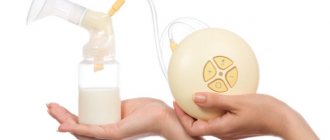Modern doctors and WHO representatives recommend breastfeeding mothers to use feeding on demand. It is this approach that allows you to optimally meet the needs of the baby. It stimulates lactation and improves breastfeeding. In this case, the newborn is fed only when he wants. The number of attachments and duration of feeding are not limited. Let's take a closer look at how to properly and how often you can feed your baby on demand.
Correct application
We talked in detail about proper attachment in the previous article (“Touch of Tenderness”). Let us only recall that it is precisely this that guarantees the absence of pain during feeding and injury to the mother’s nipples; ensures effective emptying of the breast by the child - and therefore prevents stagnation of milk in the breast and mastitis; creates full breast stimulation to produce new portions of precious nutrition; promotes good weight gain in the baby; protects him from swallowing air during sucking; helps the correct formation of the baby's maxillofacial skeleton and maintain the beautiful appearance of the mother's breast. The importance of proper attachment for maintaining breastfeeding is difficult to overestimate!
Frequent and prolonged feedings
Lactation consultants often repeat the same phrase: milk production is a hormone-dependent process. That is, one that depends on the presence of two hormones in a woman’s body - prolactin and oxytocin. The higher their level, the more milk a nursing mother has and the more complete lactation. How can we ensure that enough of these hormones are produced? The answer is very simple: the amount of “maternal” hormones is affected only by the frequency and duration of the baby’s breastfeeding. That's all! The more often and longer the feeding (provided that the baby latches onto the breast correctly!), the more milk is produced. If the amount of milk depended on other factors, then we would observe the filling of a grandmother’s breasts after drinking tea with milk, or a nulliparous neighbor would turn into a lactating woman after a course of homeopathy and taking medications. By the way, it was the discovery of these patterns that made it possible to explain the mechanisms of milk production in wet nurses, and in our time helps foster mothers to feed their adopted child.
What is meant by “frequent and prolonged feedings”? First of all, this is an orientation toward requests for sucking from the child himself. The baby grunts in his sleep, opens his mouth, sticks out his tongue, puts his fists in his mouth, tries to suck on the diaper - don’t wait until he starts crying and “demanding” the breast! Start feeding him at the first sign of anxiety. Even while changing clothes, having a massage or walking. Even if this means interrupting your swim or going into seclusion in a public place.
Usually, during the first two months, the mother learns to accurately guess the baby’s requests for milk: he wants to suck in order to fall asleep; upon awakening (if he begins to whine or cry); often - in a dream (sometimes it is enough to react quickly and quickly give the breast so that the baby, after eating, falls into sleep and further); when you feel physical discomfort (wants to have a bowel movement, is already wet, pain or cold, heat or headaches due to changes in atmospheric pressure...); with any, even the most minimal, psychological discomfort (missed without mom, scared of a new person, tired of being in an unfamiliar place, got too many vivid impressions...). And there may be many more reasons to receive those substances that are contained in mother’s milk! The frequency and duration of attachments are very dependent on the age of the child - his needs change, his sense of self and relationship with his mother change, sucking skills and behavior under the breast improve. But they usually talk about the need for 10-12 applications per day to maintain full lactation.
When providing on-demand feeding, care must be taken to ensure that both breasts are offered approximately the same number of times. As a rule, mothers do this: if the baby suckled for a long time from one breast, next time we give him the other breast to feed. If the baby is attached for a short time, then the same breast is offered several times. This recommendation is associated with the peculiarities of changes in the composition of milk depending on the duration of sucking (sometimes they talk about dividing the milk into front milk, which comes to the baby at the beginning of latching, and back milk - later in time, more caloric and fatty), as well as with the peculiarities of the lactation process itself: if If you feed less from one breast than from the other, it will produce less milk.
An important addition: the hormone prolactin is produced not least due to night breastfeeding. There should be at least three of them per night. If your baby takes a long break from sucking at night, the milk will most likely run out soon. And if you have weaned your baby from waking up at night (tried to calm her down without breastfeeding, ignored signs of anxiety and crying, offered her a bottle or pacifier to suck on) - then you can also not count on long-term maintenance of lactation. Night feedings are most complete and convenient when the mother feeds while lying down and sleeps with the baby. There are different options for organizing feeding and sleeping - find the one that works best for you and your family by studying the experiences of other long-term breastfeeding mothers or consulting with a lactation consultant. Baby needs milk at night - and your breasts absolutely need stimulation in the dark! It’s possible to combine mother’s need for rest and night feedings!
FEEDING ON DEMAND: MOST COMMONLY QUESTIONS
“Offer the breast to the baby as often as he asks!” - calls the World Health Organization in its recommendations for establishing successful breastfeeding. “Frequent and prolonged sucking of the mother’s breast is the key to a sufficient amount of milk and a necessary condition for the successful physical and mental development of the child,” their Russian colleagues repeat after foreign pediatricians. However, the experience of lactation consultants shows that not all mothers imagine what on-demand feeding looks like in practice. How exactly does a baby ask for the breast? Why does he want to nurse again 15 minutes after the previous feeding? How long should you hold your baby at your breast? Does frequent application damage the delicate skin of the mother's nipples? Is it necessary to express if the baby nurses frequently and there is little milk left in the breast? Unfortunately, many maternity hospital workers and local pediatricians, while recommending feeding the baby on demand, also cannot always explain what this looks like. Their personal experience of feeding babies was different - after all, the old recommendation of feeding by the hour excluded the mother from focusing on the child’s frequent need for milk. The initiative to put the baby to the breast belonged entirely to the mother and the dial, and the demands from the baby were ignored.
Why is “on demand” better?
But now, the era of regimented feeding is over, happily remaining in the experimental 20th century! Fortunately for babies, mothers are returning to the natural, given by nature and proven by evolution, way of organizing feeding at the request of the child. There is another, more accurate name for feeding, focused on the NEEDS of the child. What exactly does this mean? Today, the physiology of babies and their mysterious childish soul is increasingly attracting the attention of psychologists, doctors and other specialists. It is thanks to them that it was possible to most adequately identify and describe the needs of the little man. Conventionally, they are divided into physiological and mental: the need for physical contact with the mother, the need for warmth, satiety, comfort, safety, the need for constant care and love, deep emotional contact with the mother , the need for a variety of sensations and impressions. And many, many others! Moreover, the younger the child, the greater the number of needs that are satisfied by sucking mother’s milk. Ideally, a baby should not cry at all, because the mother has a breast to suck on and hands to comfort and eliminate the cause of discomfort. Milk contains more than 400 components that guarantee the normal development of the child’s body and a timely response to ANY need of the baby: drink, eat, fall asleep, calm down, be consoled, digest a lot of milk, have a bowel movement, release gas, normalize the intestinal microflora, recover, ensure active work quickly to the growing brain, regulate the activity of the nervous system and much, much more! We hope that even these few lines are enough to describe the limitless dependence of the baby’s health and development on the timely receipt of the required portion of milk to satisfy his immediate needs.
How exactly do babies ask for breastfeeding?
Don't wait for demanding cries in an attempt to justify the name "on demand!" You should offer to nurse at the FIRST sign of concern. As a rule, this is enough to prevent further upset of the baby. A newborn shows his desire to receive his mother’s milk by opening his mouth wide, turning his head in search of the nipple, grunting, whimpering, and trying to suck on a fist, a diaper, or a piece of clothing. An older baby can already express his request to be fed in a more specific way: gestures, movements, interjections, words. The general rule for establishing on-demand feeding is to attach the baby to the breast in response to any discomfort. And then it will become clear what exactly the baby wanted at the moment: to quench his thirst or hunger, to fall asleep, to pee, to change his body position, to warm up, or he was simply bored alone. The baby calmed down after receiving the milk, the mother eliminated the cause of the discomfort and you can move on with your life calmly and cheerfully!
Attention! The very concept of feeding on demand excludes the possibility of replacing the breast with a pacifier or bottle. If the mother uses these items, then it would be terminologically correct to say that the mother feeds according to a schedule, introducing restrictions on the baby’s access to the breast
How often do they need breast milk?
We mentioned above that the younger the child, the more of his needs are satisfied due to the composition of milk. For example, a new portion of food helps a one-month-old baby comfortably empty his intestines or get rid of gas accumulation, while a 5-6 month old baby can cope with this task without sucking. A grown-up toddler, if he wants to cuddle up to his mother, will simply climb into her arms and hug her - and a younger baby knows one way to achieve deep and tender unity: to suck on his mother’s breast. Therefore, the smaller the baby, the more often he asks for the breast. Even 10-15 minutes after the previous feeding! The baby's gastrointestinal tract is designed for a round-the-clock supply of breast milk. The stomach itself “rests” almost all the time, that is, it does not participate in the digestion of milk, this is done by the baby’s intestines. Therefore, we will feed the baby often during the day and - which is especially important for producing a sufficient amount of milk - at least 3 times a night. Typically, a child of the first year of life needs a total of 15-20 attachments per day. After a year, their number may be reduced to 8-12. A baby ready for weaning sucks only 1-3 times a day.
How much time can a baby spend at the breast?
In solving this issue, we also need to focus on the needs of the baby. With breastfeeding organized in a natural way, the duration of attachment can vary from 1 second to 1-2 hours, depending on the task that the baby now faces. Short latches are mainly associated with a feeling of thirst, because breast milk is approximately 90% water; with the need to obtain energy when tired, with the need to ensure normal functioning of the nervous system during overload (while walking, during a stressful situation, in pain and fear) and to maintain the level of glucose in the blood necessary for full brain activity. They help the baby obtain substances from the foremilk, which, with longer sucking, changes its composition and becomes more fatty and high in calories. Long feedings (10 minutes or longer) help the baby solve the problems of growth and weight gain, brain growth and development of the gastrointestinal tract, normalize digestive processes and ensure the formation of strong immunity. Babies can nurse for a long time in the first weeks after birth, when falling asleep (at any age), when they are ill, when teething, when there is psychological discomfort, or when there are difficulties in establishing deep emotional contact with their mother. Babies nurse especially for a long time in the early morning hours; it is at this time that the mother’s body actively produces the hormone prolactin, which is responsible for a sufficient amount of milk, in response to breast stimulation.
Therefore, you should not take the breast before the baby releases it HIMSELF - otherwise he risks not receiving anything important from your milk, and the breast will not receive the “request” to produce a new large portion of precious nutrition! Be patient, choose a comfortable position for feeding (lying down, for example, or placing the baby in a sling), take care not to get bored during these moments (knit, listen to music, read, chat, take a nap...:) - but only don't watch TV! ) - and feed! As long as the baby requires at the moment. Of course, there are exceptions to the rule related to the mother’s need to interrupt the sucking process: she urgently needs to open the door, go somewhere, do something... But these should be exceptions, and not regular practice.
How does he behave during attachment?
Very, very different! It all depends on the situation, mood, well-being of the baby and mother, as well as on the purpose of each specific application, on the need that it satisfies. For example, a hungry baby can suck actively for several minutes, sometimes even very “greedily.” A falling asleep baby will suck almost imperceptibly, making literally 2-3 sucking movements per minute. To quench their thirst, babies suck intermittently, often getting distracted and interrupting feeding. The baby can suck with his eyes closed (mainly during the newborn period and at the moments of falling asleep), he can twist and turn, try to stand up, push with his legs and arms. He can smile at mom, without letting go of his breast, and try to follow with his eyes where dad went. His tummy may be bubbling (activation of intestinal peristalsis) and gas may be released. He can poop, sweat, he can hug his mother with his hands and curl up. In general, every attachment is an entertaining creative process in the relationship between mother and child! The only thing the baby should not do is cry during and after sucking. Crying under the breast is the first sign of the most serious problem with breastfeeding - breast refusal.
Is prolonged sucking harmful to the skin of the breast?
Here we come to one of the most important concepts in organizing successful breastfeeding - CORRECT ATTACHMENT. When latching onto the breast, the baby should grasp the entire brown areola and areola as deeply as possible. The radius of areola capture is 2-3 cm from the base of the nipple. In this case, the nipple itself is located deep in the baby’s mouth, without risk of injury. The main criterion for correct application:
- absence of breast tenderness in mother;
- certain external signs: at the moment of sucking, the areola is practically invisible, the baby’s lips should be turned outward, ensuring a tight seal (and, as a result, air does not enter the baby’s stomach), the chin is pressed to the chest, and the cheeks and nose touch it.
Proper latching not only protects your nipples from injury. Due to the effect of high-quality emptying of the mammary gland, it also prevents milk stagnation in the breast and mastitis. Try to teach your baby to breastfeed correctly as early as possible! If you are unable to master this on your own, you can always take the help of lactation consultants.
But what about pumping?
If you have organized natural feeding for your baby, then there is no need for regular pumping. Your mammary gland, sensitively responding to the “requests” and “demands” from the baby, produces as much milk as he needs. No excesses or shortcomings. Frequent sucking with proper breast latching will insure you against stagnation that occurs when feeding according to the old, “regime” scheme, when each breast “stands idle” for 6-8 hours, waiting for its turn. You need to pump only if the mother is separated from the baby, works outside the home, or is engaged in establishing natural feeding in difficult cases under the supervision of a breastfeeding specialist and when feeding according to a regimen.
How can you manage everything else if you breastfeed often?
To organize life with a small child, a woman who has just given birth certainly needs help with housework. The basic principle of life after childbirth: the mother takes care of the child, and those around her take care of the mother. Most household issues can be resolved without the active participation of a nursing mother. With the modern level of civilization, it is not so difficult to shift the responsibility of doing laundry in the washing machine, preparing frozen foods, shopping, and keeping the floor clean with a vacuum cleaner onto the shoulders of other household members. Moreover, those around you are also interested in the baby growing up healthy, calm, and not crying or being capricious. For this reason, it’s worth spending most of your time feeding while the baby is small, knowing that over time the situation will change ! The child will grow up, become more independent, the need for milk will be less, and the mother will have more free time. Many breastfeeding women benefit from the use of a sling sling, which allows them to do simple household chores without taking their baby off the breast, moving freely around the apartment and beyond.
Maria Gudanova,
Member of the Association of Breastfeeding Consultants
Published in the magazine “My Child” under the title “We feed always and everywhere”
Gudanova Maria Vadimovna
Consultant on breastfeeding (AKEB) and child care.
Experience: 17 years
Call to home
You can consult by phone or call a lactation consultant at home by calling our breastfeeding hotline (daily from 7.00 to 23.00).
Previous
Next
No pacifier needed
Why is the WHO so negative about pacifiers, nipples and bottles, calling them “foreign oral objects”? Are they really dangerous and can cause harm to breastfeeding? Let's try to figure it out.
Firstly, the very use of a breast substitute eliminates the possibility of feeding the baby on demand. Or, in response to a request for sucking, we give the breast - and then we exactly feed the baby in accordance with the rule discussed above. Either we introduce restrictions on access to the breast, and it would be terminologically correct to call this option of breastfeeding “regular feeding.” Why is it dangerous to feed your baby according to a schedule?
- The time the baby spends at the breast is reduced, as a result of which the mammary gland does not receive sufficient stimulation to produce the required amount of milk - it becomes smaller day by day. Regular pumping in this case will not help maintain lactation for a long time.
- The baby does not receive enough substances necessary for growth and development, which is why he may gain weight poorly or acquire various diseases (dysbacteriosis, constipation, increased excitability, developmental delays).
- The quality of mutual understanding between mother and child decreases: the baby gets used to the fact that his needs are ignored or not recognized by adults; the mother does not feel the difference between the various states of the baby.
Secondly, sucking artificial substitutes for the mother's nipple in 98% of cases spoils proper attachment. We mentioned the possible consequences of poor breast latch above and in previous articles.
Thirdly, if a mother gives her baby a pacifier or bottle, there is a risk that the baby will refuse the breast. How to understand that such a risk exists? Periodically, when the mother tries to attach the baby to the breast or during the first minutes of sucking, the baby begins to cry, release the breast from her mouth and arch. It may just suck very restlessly, sometimes whine, refuse to fall asleep or calm down with the breast. All these are signs of breast refusal, which can progress and lead to the baby’s complete reluctance to suckle from his mother.
Fourthly, infection can easily enter the baby’s body through pacifiers and bottles. Perhaps it is because of this that babies who are bottle-fed get sick several times more often than infants.
But what to do if a mother needs to leave home without her child? What if there is a need to give medicine? If supplementary feeding is prescribed for medical reasons?
For these cases, the World Health Organization recommends using a spoon, cups, special sippy cups, syringes without a needle, a supplementary feeding system, a pipette and some other methods of giving the required amount of supplementary feeding. Experience shows that it is not difficult to teach a person who is responsible for caring for a child in the mother’s absence not to bottle feed. A convenient feeding schedule is drawn up, the basics of baby care are taught, as well as the secrets of calming and putting the baby to sleep without sucking. As a result, these babies do just fine without pacifiers and bottles!
Benefits of schedule feeding
- The baby receives all the necessary substances and elements for harmonious growth and development;
- The child suffers less from gas, colic and stomach upsets. It is less susceptible to allergic reactions, and the baby develops a strong immune system;
- The baby receives the required amount of food and does not need to be supplemented with formula milk;
- The baby does not need to be supplemented with water or fed with formula milk. There is no need to introduce early premature complementary feeding;
- Regular and natural breastfeeding on demand does not require pumping;
- Regular latching satisfies the sucking reflex 100%, calms the baby and allows you to do without a pacifier;
- Children grow up healthy, more confident and calm. In addition, the child does not develop such bad habits as sucking a finger, fist or other objects;
- Feeding on demand provides a calm and comfortable environment, establishes contact between baby and mother;
- Feeding your baby on demand has a positive effect on sleep. on the psychological state and development of the baby;
- Frequent feeding is an effective stimulation of breast milk production, as well as the prevention of lactostasis, mastitis and various other breast diseases in nursing women;
- This method of feeding improves lactation, which avoids problems with a lack of milk for the newborn. Read how to establish breastfeeding here.
Water and complementary foods
Babies in the first six months of life do not need to be given additional fluids or nutrition in addition to natural breastfeeding. The World Health Organization conducted special studies in the countries of the equatorial belt to clarify the issue of supplementing infants with water. The conclusions are clear: even in the hottest climate, babies do not require anything other than mother's milk, which they receive on demand. Milk itself is approximately 90% water. Moreover, it is the most sterile, balanced and ready to use!
The minimum period for starting the introduction of complementary foods is six months. Until this age, milk fully satisfies all the nutritional needs of an infant. And the gastrointestinal tract has not yet matured for the high-quality absorption of adult food. When trying to feed a baby with complementary foods at an earlier age, the digestibility of breast milk may deteriorate and the immature abdominal organs may suffer from untimely loading. Even formula-fed babies are not recommended by WHO to be fed adult foods until they are six months old.
How to give medication to a baby? We offer it from a spoon (pipette, cup and any other objects that cannot be sucked). We try to ensure that treatment does not lead to a decrease in the number of applications. Since milk is not strictly a food, does not overload the gastrointestinal tract and has the ability to digest itself, there is no need to maintain intervals between taking the medicine and feeding. If the medicinal substance is recommended to be diluted in water, in some cases you can use expressed milk. We strongly recommend that you resolve questions about the need to give medicine to your baby with a doctor who understands the importance of long-term breastfeeding and has a good knowledge of the composition of milk and the characteristics of its production. Why do we consider this an essential point - knowledge of the composition of milk? The fact is that, as a rule, many of the advertised products for improving the health of a baby simply duplicate those substances that are already contained in human milk. A good example in this sense is drugs “for intestinal colic” and bacteria for “normalizing microflora”. But it is precisely the function of regulating the activity of the baby’s immature intestines that is performed by the Bifidus factor of breast milk! Therefore, giving such medications to a baby who is fully breastfed is simply pointless - everything necessary for his health is already in his mother’s milk! It is also important to know that if the volume of the drug exceeds 40 ml per day, there is a risk of a decrease in milk supply (the baby’s sucking activity changes and the amount of time spent at the breast decreases). What to do in this case? Of course, get treatment. And then, if there really is less milk, make every effort to return lactation... We will try to talk about how and when it is best to introduce complementary foods in the following articles.
“I don’t have enough milk!”
What signs does a nursing mother most often name when making such a “diagnosis”?
- The child often wakes up and cries
- Unable to express breast - only a few milliliters of milk are released
- The baby eats little at one feeding
- Breasts do not fill up between applications
- Small breast size
- Poor weight gain in a child per month
- The baby does not have a bowel movement every day
- The baby refuses to suckle, cries, knocks his legs and bends over
- Baby asks to be held to the breast too often
Dear breastfeeding women! None of these signs are enough to qualify you as a “non-dairy mom”! In a baby's life, not all problems come down to lack of nutrition. Any of the above symptoms may have a completely different cause than a lack of milk in the mother. For example, a weight problem is often a reaction to the psychological stress experienced by a child (if the baby cries a lot; in the case of a difficult birth for him or a caesarean section; lack of contact with his mother, etc.). And the amount of milk extracted from the breast during pumping may reflect the individual structure of the mammary gland, which is not designed for the loss of “fluid” from any outside touch.
We hear many other mythical signs of lack of milk, which are readily replicated by grandmothers, girlfriends and doctors who have never breastfed. However, in world practice there is the only reliable way to determine the sufficiency of nutrition received by an infant. There is even a special term for it - daily diuresis. Simply put, how many diapers does a baby wet per day? It is clear that you don’t have to use diapers or diapers to count the number of urinations - otherwise there is a risk of missing the “X” moment. But the approximate number of “wet cases” per day should be more than twelve (for infants under six months). If your baby pees more than 12 times per day, you have a lot of milk! If urination is observed less frequently, there is a reason to work on increasing lactation.
And for problems due to which there is a suspicion of a lack of milk, you need to look for another reason. With a sufficient number of daily urinations, you will have enough milk!
And yet there is not enough milk...
What should you do if your baby doesn’t pee often enough—less than 12 times a day?
- Don't panic and despair!
- If the number of urinations drops below six (for children over a week old), immediately supplement with formula or donor milk and seek help. In these cases, there is a risk of dehydration of the child's body.
- Take a close look at the rules for successful breastfeeding formulated by WHO - you probably cannot fulfill some point... Maybe there was separate housing in the maternity hospital and you rarely fed your baby? Maybe you have cracked nipples - but this is a sure sign that the baby is not latching onto the breast correctly. Or maybe you can’t imagine life without a pacifier? Or did the husband take on part of the night care for the baby and give him a bottle at night? Dig into the situations that happen every day in your life with your baby - and deviations from the rules will definitely come to the surface!
- Having discovered a possible cause, eliminate it. Throw away the pacifier, start feeding at night, and watch out for signs of discomfort in the baby (by the way, the ideal situation is when the baby does not cry at all). Try to put your baby to your breast as often as possible. Learn to do it right. If you feel the need, consult a lactation specialist.
- Can't find the reason? You've done everything and fixed it, but you still don't have enough milk? Discuss your situation with a lactation specialist. The lack of results in increasing your milk supply is not at all a reason to admit defeat. This is a reason to look for deeper causes and use the most effective ways to eliminate them.
More optimism!
Breastfeeding is a very natural process. Following only her own intuition, any mother will be able to formulate the same rules for successful breastfeeding as the WHO. Respond to your baby's needs in a timely manner; look for ways to overcome difficulties; do not deceive the baby by putting breast substitutes in place of breasts; be responsive not only during the day, but also at night; agree to the inevitable revision of life priorities and do not succumb to the negative pressure of the environment. Your baby believes in you. He knows that you will do everything possible to feed him with your milk.
We wish you success in organizing natural feeding!
Maria Gudanova, natural feeding consultant, member of the Association of Natural Feeding Consultants
What does Komarovsky say?
The famous children's doctor Evgeny Komarovsky is not against, but is not a supporter of feeding on demand, however, as well as feeding infants on a schedule. What is his opinion about the main types of breastfeeding for a child?
- Feeding infants at intervals, at first glance, allows the mother to feel more free. However, Komarovsky is sure that it is extremely difficult to maintain such a schedule, and the night turns into a period of continuous tears.
- If you feed your baby on demand, you will not be able to enter the optimal mode. Komarovsky is also convinced that not every mother will be able to give breast milk 25-30 times a day.
Komarovsky is confident that the best solution for a woman and an infant will be the so-called free feeding. Pediatrician Komarovsky suggests feeding the baby at his request, but not more than once every three hours. This mode continues at night.
This type of feeding is ideal for infants and active women. This is what Dr. Komarovsky thinks, but whether to listen to his opinion is up to the individual nursing mother to decide.











